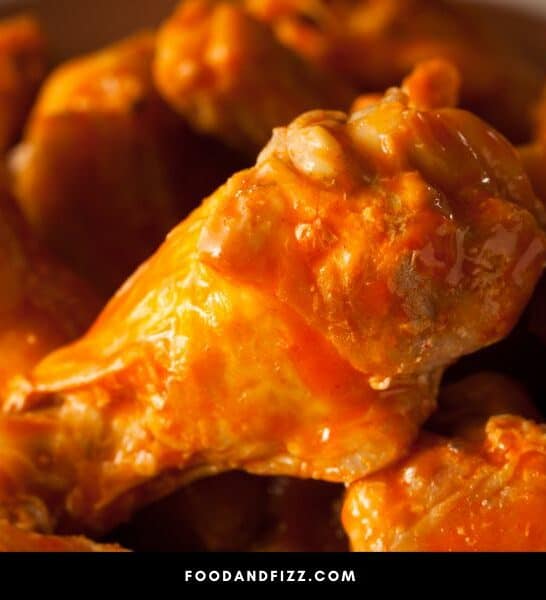What happens when you put spicy chicken wings and people’s natural curiosity and competitiveness together in a sports bar? The Buffalo Wild Wings Blazin’ Challenge, of course!
What Is the Buffalo Wild Wings Blazin’ Challenge All About?
The Buffalo Wild Wings Blazin’ Challenge requires eating 10 Blazin’ wings doused in a Carolina Reaper-based sauce, in 5 minutes or less, without drinking anything or taking any sort of break. Those who have successfully completed the challenge get personal glory, bragging rights, appear on the Blazin’ Challenge Wall of Fame and get rewards points from the restaurant.
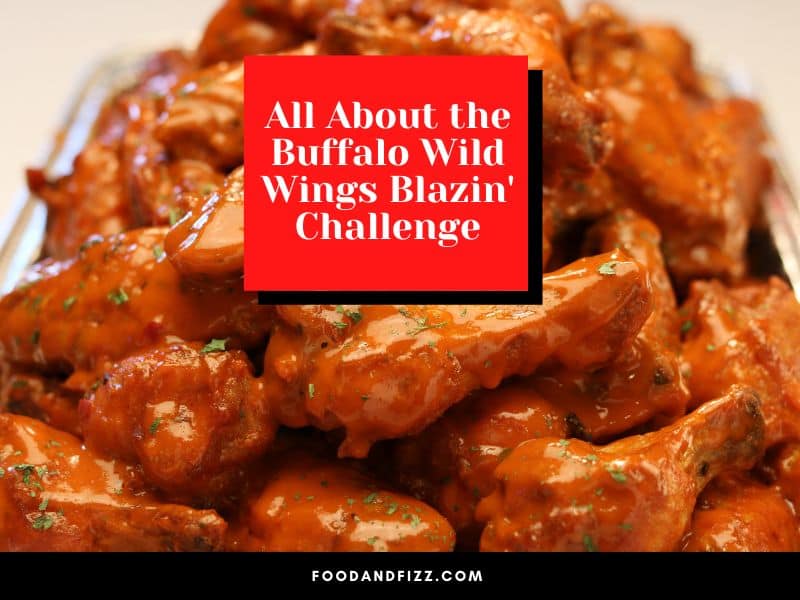
The Buffalo Wild Wings Blazin’ Challenge – 10 Things You Need to Know
The Buffalo Wild Wings Blazin’ challenge has been around for several years and has been attempted by many celebrities, Youtube and Tiktok personalities, as well as many other spice lovers.
If you want to attempt to join the challenge, here are 10 things you should know.
1. You have to sign a waiver first.
Before they can let you participate, you have to sign a waiver. This means you proceed at your own risk and the restaurant has no liability in whatever ensues in the challenge.
2. You must be 18 or older.
If you are a minor, you can get consent from a parent or legal guardian to join but unless you are 18 years old, you cannot join the rewards program and therefore cannot get rewards points, and you also are not eligible to be on the Blazin’ Wall of Fame.
This means that as a minor, your only reward is probably just personal glory. I would wait until you are over 18 so you can get more out of the excruciating experience!
3. You have to eat 10 wings in 5 minutes or less.
You have 5 minutes or under to complete your mission.
4. An employee will officially time you.
Talk about pressure! There is an official timekeeper and an official witness to how you go about the challenge.
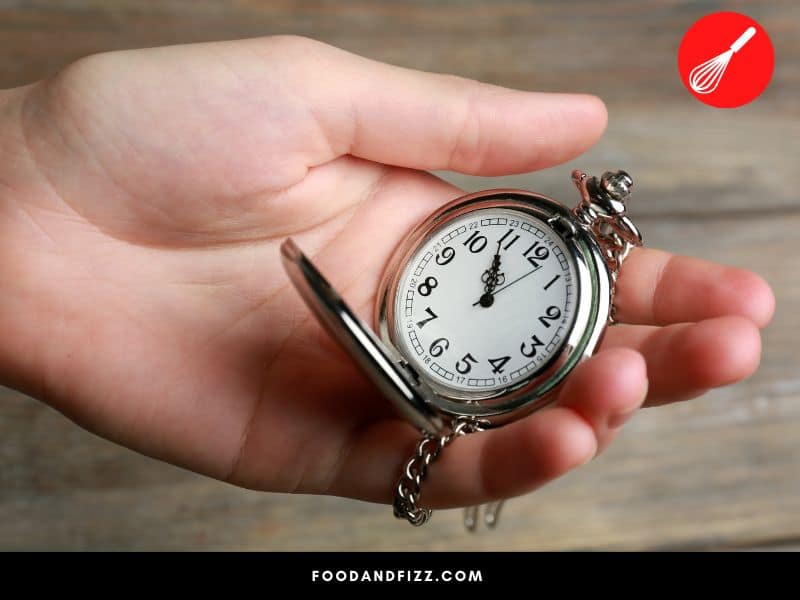
5. The wings are coated in their spiciest sauce – Carolina Reaper sauce.
Carolina Reapers are the spiciest peppers in the world and are way high up on the Scoville scale. This means that they burn, and they burn bad.
6. You can’t take breaks and can’t drink anything.
Not that water will help your case but you can’t drink anything during the challenge, nor can you take bathroom breaks.
7. You can’t consume it with any other type of food, including dressings and condiments.
Not only can you not drink, you also cannot have condiments that may make the spices more tolerable, such as bleu cheese or other dressings. You can’t get help from dairy.
8. You can’t use your hands. Remove wing meat with your mouth only.
Nor can you get help from your hands. Aside from holding the wings in place, all meat extraction must be done with your mouth. Where it just burns and burns.
9. If you vomit or regurgitate food, you are disqualified.
To get through the challenge successfully, you have to hold your vomit or any urge to throw up the food until after. Hold it in and get a grip, or else you are disqualified.
10. You have to consent to a photo.
They didn’t say that your photo will be up on the wall somewhere, but in this day and age, everything is documented somewhere, whether it be officially or on your friends’ or family’s social media accounts.
If you want to take part in this challenge, prepare yourself for photos – lots of it. There’s no guarantee that you will look great in all of them, painful chili experience and all, but hey, you will be popular.
What Do You Get When You Complete the Buffalo Wild Wings Blazin’ Challenge?
When you have successfully completed the Buffalo Wild Wings Blazin’ challenge, you get three things:
- 1,000 Rewards Points
- Your name or photo up on the Blazin’ Wall of Fame
- Bragging rights
Aside from this, you will definitely get personal glory and satisfaction at having pushed yourself to the limit and having achieved a remarkable feat. There’s something special about coming out victorious against a truly formidable foe.
How Spicy Are Blazin’ Buffalo Wild Wings?
Buffalo Wild Wings Blazin’ wings are made with Carolina Reapers, the hottest and spiciest peppers in the world. The Scoville scale records Carolina Reapers’ spiciness at 1,500,00 to 2,300,000 SHU.
Jalapeño peppers, on the other hand, sit at just between 2,500-8,000 SHU. Imagine how spicy that Blazin’ sauce is!
To know more about the Scoville scale and where Blazin’ Buffalo Wild Wings are on the Scoville scale, check out How many Scovilles Do Blazin’ Buffalo Wild Wings Have on the site.
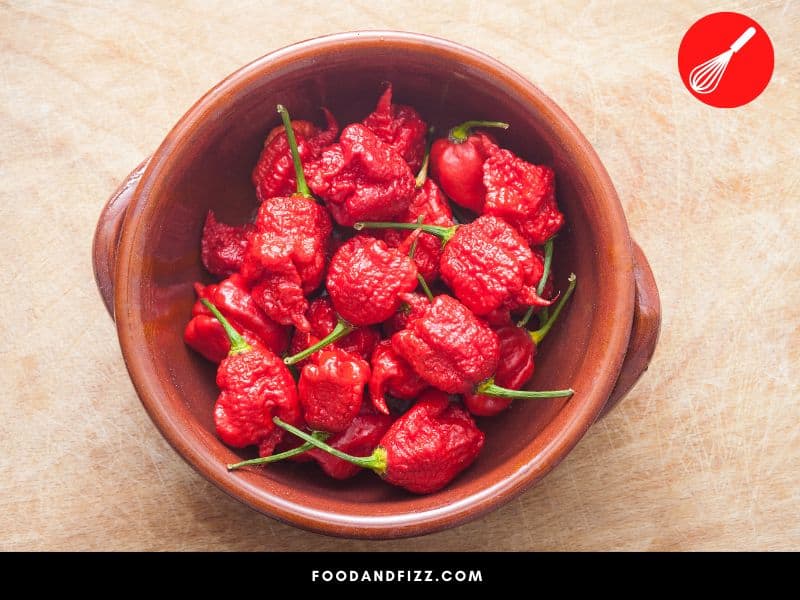
What Are the Spiciest Buffalo Wild Wings Sauces?
Buffalo Wild Wings’ spiciest sauces include the Blazin’ Carolina Reaper sauce, Dessert Heat Dry Seasoning, Wild Sauce, and Mango Habanero sauce.
The Mango Habanero sauce is actually quite a popular sauce of theirs as well, and we actually explored it a bit in this article How Many Scoville Is Buffalo Wild Wings Mango Habanero Sauce?
What Can Help Remove the Burning Sensation in My Mouth After Eating Spicy Food?
Whether accidentally or on purpose, we’ve all been there: sweating, mouths burning, literally in pain, and thinking we’re about to die from that spicy dish we just consumed.
What are the best ways to get relief?
Milk and Other Dairy Products
Milk and milk products contain compounds called casein, which help break down capsaicin and neutralize the capsaicin molecules that have not found a receptor yet by binding to them.
This diminishes the burning sensation you feel, and while it may not necessarily erase the feeling completely, it certainly prevents things from further escalating and making you feel worse.
According to one study, more than water or any other beverage, milk seems to be the most effective way to neutralize the mouth burn from spicy food.
This is also the reason why after most eating challenges with spicy food, ice cream is typically recommended.
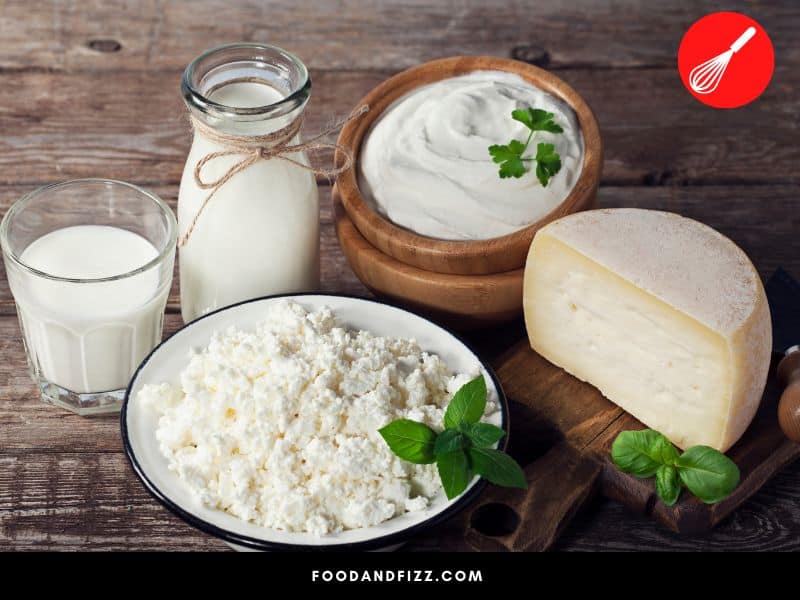
Other Acidic Food and Drink
When isolated, capsaicin is actually an alkaline compound, contrary to popular belief. This means that the introduction of an acid like lemon, lime or orange juice or any acidic food or drink like tomatoes, can greatly help in neutralizing it. Milk is also acidic, and is also why it is an effective mitigator of heat caused by capsaicin.
Lemon or lime juice is typically added to too spicy dishes to tone down some of the spiciness, and it will work just as well in cooling down your mouth of the burning sensation. While it may not necessarily make it go away completely, it certainly helps tone it down.
Sugar Cube or Honey
Sucking on a sugar cube or taking in some honey can greatly help in lessening the burning sensation from eating something that’s too spicy.
If you’ve ever read anything about the Scoville scale, you will know that the scale was actually developed in the 1900s by a pharmacist named Wilbur Scoville, who used a sugar-water mixture to dilute the effects of the capsaicin until it cannot be detected anymore.
The higher the amount of sugar water needed to dilute the same amount of the chili pepper, the hotter the pepper is.
So sugar, while it may not really erase the effects of the burning sensation, may help minimize it or at least distract your body from the sensation until it dissipates.
Bread and Other Carbohydrates
Bread and other starches and carbohydrates can act like a mop in your mouth to soak up some of the capsaicin so it won’t cause more trouble for you. They act as barriers between your tongue receptors and the capsaicin, so they don’t have anywhere else to go.
Olive Oil
Capsaicin is oil-soluble, so taking in oily foods can help neutralize some of that burning sensation in your mouth. Swishing around some olive oil in your mouth can help reduce the painful sensation, as well as eating in some oil-rich foods like peanut butter.
What Will NOT Help Help Remove the Burning Sensation in My Mouth After Eating Spicy Food?
So we’ve looked at the things that may help minimize the burn from spicy food. What things should you avoid?
Water
This may seem counterintuitive as water is likely the first thing you would want to drink after an unfortunate encounter with spicy food, but it actually is a bad idea.
Capsaicin is oil-soluble, meaning water will not do much to neutralize it. If anything, it will help spread it around, and make things worse. So put down that glass of water!
Ice cubes though, may help a little bit. The water certainly won’t but the cold temperature of the ice cubes may dull the pain a little bit and provide some relief.
Alcohol
Alcohol does dissolve capsaicin, but you would need to consume a whole lot of it for it to actually be effective. Hard liquor works better than beer, as beer has high water content, and we already know water doesn’t do squat for capsaicin burn.
But unless you want to drink yourself into oblivion to numb the pain, I wouldn’t recommend going this route! It certainly isn’t the responsible choice, and you may wake up feeling much, much worse.
Another Option: Desensitize Yourself to the Heat
Now whether you take this approach or not depends entirely on you, but I just thought I’d mention it here. It is a fact that the more we eat spicy food, the more tolerance we build up for it.
People who don’t like spicy food or don’t have it often will probably find jalapeño peppers to be really spicy. But if you consume spicy food on a regular basis, you may become desensitized to the spiciness offered by jalapeños, and may reach for a stronger pepper.
If you want to minimize the burn you feel when you eat spicy food, you can build your tolerance for it by having more of it. Over time, your body will adapt, and your perception of what is spicy aka “dangerous” from the body’s perspective, will have changed.
I personally enjoy spicy food and I think I have more tolerance for it compared to other people, but I’m certainly nowhere near the level that I would ever attempt to do a Blazin’ Buffalo Wild Wings Challenge!
What Happens When You Eat Spicy Food?
Capsaicin is a compound that determines how hot or spicy a chili pepper is. It is what gives your mouth that “burning sensation” after it is exposed to something spicy. The concentration of capsaicin in chili peppers determines where they place on the Scoville scale. The more capsaicin that is in the pepper, the spicier it is.
The Scoville scale is not just used for measuring the heat level of actual peppers, but it is also used to measure the spiciness of condiments and other food that include chili peppers in them.
For example, Buffalo Wild Wings’ sauces are also assigned Scoville units, as well as things like Flamin’ Hot Doritos, since these all have chili peppers in their ingredients. (If you are curious where Flamin’ Hot Doritos sit on the scale and how they stack up against the Buffalo Wild Wings Blazin’ Carolina Reaper sauce, check out How How Are Flamin’ Hot Doritos in Scoville).
Save for pure capsaicin which can be extremely dangerous when consumed in large amounts, peppers, and spicy food will generally not cause any harm to your body, despite the actual physical pain that you may feel while eating them. That said, though, it may exacerbate existing medical conditions.
So what happens when you indulge in too spicy of a meal?
According to University Hospitals, the following happens when you eat spicy food, due to the action of capsaicin:
- Burning sensation in the mouth as the capsaicin binds with the pain receptors, which goes down all the way to the chest. The esophagus also has these TRPV1 receptors.
- Irritation in the throat which can cause breathing difficulty and hoarseness of the voice.
- Can cause heartburn.
- Can cause irritation in the diaphragm that can lead to hiccups.
- Stomach pain and cramps as your stomach increases its metabolic action in the attempt to empty your stomach of the offending capsaicin.
- Nausea and vomiting
- A faster rate of digestion which can cause diarrhea, since your body is attempting to rid itself of the capsaicin.
- Pain during bowel movements. Capsaicin binds with more pain receptors which makes you feel more pain.
Capsaicin is viewed as a threat and irritant to the body, that’s why your body will do whatever it takes to get rid of it. No long-term harmful effects will persist in healthy individuals, but if you have the following conditions, capsaicin may make your symptoms worse:
- Irritable Bowel Syndrome
- Acid Reflux
- Inflammatory Bowel Disease
- Gastritis
- Peptic Ulcers
- Anal Fissures
To prevent any complications, if you have any of these conditions, it is best to minimize your intake of spicy food.
Why Is Eating Spicy Food Painful?
Do you feel pain when you eat spicy food? There’s a good reason for this.
The Pain is Real, but the Threat Isn’t
Capsaicin is a clever little trickster. While compounds in other food bind with taste receptors in the mouth so that they give us the taste profile of whatever it is we are eating, whether it be sweet, salty, sour, bitter, or umami, capsaicin ignores all that and binds with temperature or pain receptors called TRPV1.
Also known as capsaicin receptors, these receptors are found all over the mouth including the tongue, and are also found throughout the digestive tract.
TRPV1 receptors are responsible for the detection of changes in temperature in the body and are the ones that alert our brains to the presence of heat, for example, if your drink is too hot or you are in an actual burning room.
They activate the “pain” signal in our brains that we are on fire, even when nothing is actually burning, and the body responds accordingly by cooling itself down and attempting to get rid of the offending compound.
This is why when we eat spicy food, we can sweat, salivate, have tears in our eyes and produce a lot of mucus. Our bodies are essentially responding to the emergency by trying to get rid of the capsaicin and cooling our bodies in the process. Our bodies think we are actually on fire, even when there is no actual threat.
So yes, eating spicy food is indeed painful–you are not imagining that bit at all. But there is no actual danger that we will be consumed in the fire so to speak, it’s just what our bodies think.
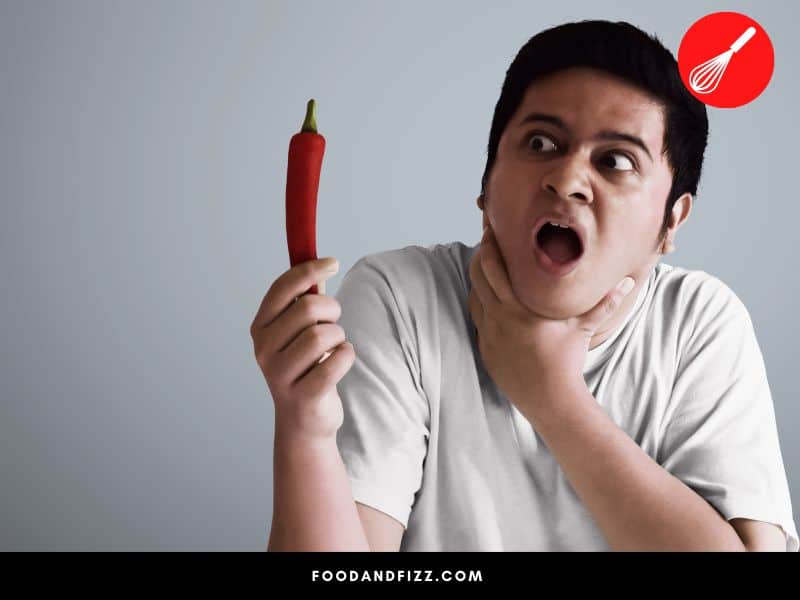
Are there Benefits to Spicy Food?
Despite the fact that it is perceived as a danger by the body, spicy food does have some notable health benefits:
- Helps with weight loss: makes you less hungry and stimulates metabolism
- Can lengthen your lifespan: A study published in the BMJ found that people who consumed more spicy food had a significant reduction in their mortality rate.
- Promotes heart health: lowers bad cholesterol and has anti-inflammatory properties that are beneficial for the heart and supports its health
- Stomach health: prevents ulcers by minimizing acid production in the stomach
- Gut health: its anti-inflammatory properties calm the gut and helps diversify the microbes in your gut
- Pain-relief: as an ingredient in medications and pain-relief patches, it can help minimize the pain you feel because of certain conditions.
Can You Die From Too Much Spice?
According to Live Science, you can technically die from eating too many chili peppers but it would be very hard to achieve. The body will falter and resist long before that point ever occurs.
They say that consuming three pounds of extremely hot chilies in pure form in one sitting can in theory kill a 150-pound man, but it would take a lot for it too happen. It has to happen in one sitting. If it is spread out over a period of time, it will not kill you.
So yes, you can die from too much spice but it is highly unlikely that you will ever find yourself in that extreme situation.
Feeling like you are dying though, is a completely different matter.
Frequently Asked Questions to All About the Buffalo Wild Wings Blazin’ Challenge
What is the Buffalo Wild Wings Blazin’ Sauce Made of?
The Buffalo Wild Wings Blazin’ sauce used to be a ghost pepper-based sauce, but was recently changed to include Carolina Reapers, the world’s spiciest pepper which packs in a maximum 2,300,000 SHU or Scoville Heat Units.
What Do I Get if I Complete the Buffalo Wild Wings Blazin’ Challenge?
You get bragging rights, personal glory, 1,000 rewards points and the satisfaction of seeing your name up on the Blazin’ Wall of Fame.
Conclusion to All About the Buffalo Wild Wings Blazin’ Challenge
The Buffalo Wild Wings Blazin’ Challenge requires the consumption of 10 Blazin’ Carolina Reaper wings within a time period of 5 minutes.
It is a challenge that has been attempted by several popular personalities, as well as Youtubers and Tiktok personalities. Many have succeeded and many still succeed to this day.
Succeeding in a challenge like this not only offers you bragging rights and a sense of personal achievement of having conquered the great Carolina Reaper, but will also get you rewards from the restaurant and have your name up on the Blazin’ Wall of Fame.

